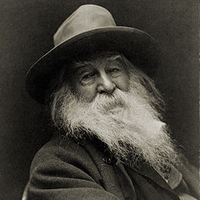Crossing Brooklyn Ferry by Walt Whitman: Summary
Crossing Brooklyn Ferry is one of the masterpieces in Leaves of Grass. Being a poet, and the voice of the people, Whitman took the role of a prophet and through his poems delivered his message to his people and to the world at large. He took the people with confidence and placed them under the sunshine of modern, healthy and vigorous outlook on life.

Walt Whitman (1819-1892)
He made people realize the reality, and enjoy life to the brim. The poem talks about the brighter aspects of life. It ends on a note of optimism.
The poet emphasizes that there is no time limit to the ferrying across the river. People, he says, were thus ferried, they are being ferried every day and they will be ferried thus for ages to come. Anyone familiar with the poems of Whitman will see how the poet tries to establish his identity with the people he sees, then, becomes one with them - one with the milling crowd and enjoys the refreshing breeze of the tides. "The summer sky in the water", "The scallop-edged waves in the twilight, the ladled cups", and their experience becomes his. The identification between him and the people or the rapport between him and the reader he thinks aloud: "What is it then between us/Whatever it is, it avails not - distance avails not/and place avails not."
Though the passengers come together only for a short time as they are ferried across, the poet finds the identification between him and the people who had ferried earlier, who are ferrying and who would also ferry in the future. This identification he elaborates in saying that he also lived in Brooklyn, Manhattan Island and that he also had the blending of opposition in him like: "Had guide anger, lust, hot wishes, I dared not speak/Was wayward, vain, greedy, shallow, sly, cowardly, malignant/Lived the same life with the rest, the same old/Laughing, growing, sleeping."
All the images of the ferry scene, he catalogues and shows he is like any other human being with the same human passions. Slowly the poet, after referring to the ordinary ferry scene, tries to establish the identity with the others- it may be voyagers; it may be the readers and it may also mean the identification of the soul which later identifies itself with the universal soul. This idea is clearly stated in the lines:
"We understand then do we not/What I promised without mentioning it, have you not accepted?/What the study could not teach—what the /Preaching could not accomplish is/Accomplished, is it not?"
After the direct identification which no books each, the poet re-invokes all the images of the ferry scene of the earlier sections which assisted the poet infusing with the reader, enabling the reader to see an additional meaning in it and persuades him to know the universal identity.
The poem itself is a ferry, shuttling across the river of time. People enjoyed reading his poems. They read this poem, and shared his experience. Even in the future, people would read it and share his experience. In this manner, the poet establishes identification with the reader, transcending time and space.
The poet shows that unity exists in diversity. People from different walks of life ferry unitedly. Everyone is separate yet also an essential part of the unity. All objects in nature and the world look separate, yet there is harmony and unity in them which go to make a "well join'd scheme," the poet after mentioning a catalogue of scenes and sights, in the last section calls on the countless crowds of passengers to cross the river from shore to shore, calls upon the sea birds to reel and wheel, and the sun-set clouds to drench him with their splendor.
Site this Page!
Shrestha, Roma. "Crossing Brooklyn Ferry by Walt Whitman: Summary." BachelorandMaster, 21 Mar. 2018, bachelorandmaster.com/britishandamericanpoetry/crossing-brooklyn-ferry-summary.html.
Related Topics
The World Below the Brine: Analysis
When Lilacs Last in the Dooryard Bloom'd: Analysis
Crossing Brooklyn Ferry: Analysis
Song of Myself (Section 1: Summary & Analysis)
Song of Myself (Section 6: Summary & Analysis)
Song of Myself (Section 11: Summary & Analysis)
Song of Myself (Section 52: Summary & Analysis)
 |
bachelorandmaster.com |